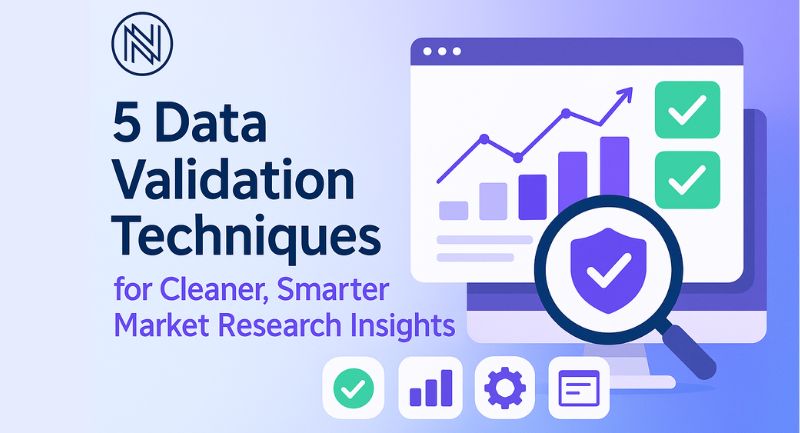
Bad inputs create bad decisions. Good validation prevents that. Organizations can reduce data-related mistakes by as much as 60% with sound validation processes, and effective validation increases decision confidence by over 50% in market research situations. Since an estimated 60–70% of business data is incorrect or incomplete, validation is no longer a choice, it’s business as it happens. These five approaches tighten up research data quality, enhance research accuracy, and get valuable insight in stakeholders’ hands sooner.
1. Source & Intake Validation: Prevent Trash on Our Beaches
Even before you create lists of responses, you need first to make sure that you’re gathering the correct sources. It’s basically pre-vetting the guest list prior to the party beginning. If you admit bots, repeats, or unqualified respondents in here, then your data will be faulty from the beginning.
Source validation at an early stage decreases intake error by around 40–50% and generates a 25% boost in data quality measures for the companies that employ intake controls. Daily steps are:
- Auditing panel origin
- Creating duplicate checks
- Requesting verified identities on high-stakes projects
- Capturing consent and location metadata at intake
At the instrument level, employ required fields, controlled dropdowns, and region-aware formatting (phone number, postal code, currency). Lightweight bot protections such as honeypots and reCAPTCHA exclude automated noise. These controls weed out a significant portion of junk before it ever hits analysts and maintain baseline data cleanliness.
2. Field-Level Validation: Format, Type, Range, and Logical Constraints
Once inputs do start coming in, the next level of safeguarding involves checking what users input. That means instituting checks on more than one level, the user interface, the server, and the data pipeline, so that errors can be caught ahead of time.
Field-level validation can reduce as much as 30% of data-entry errors related to invalid numeric or text inputs. Primary methods are:
- Type validation (numeric, date, email)
- Business-range checks (age, price)
- Cross-field logic (start/end dates, dependent selections)
Consistency checks across related fields can reduce mismatches by as much as 20–25%. Localize constraints by market and review them in the ETL process to avoid hidden errors. The payoff? A dataset that conforms to business logic when it reaches analysis, a big victory for downstream confidence.
3. Triangulation & Cross-Validation: Corroborate What People Say
Self-reporting surveys are notoriously noisy. Humans forget, misreport, or lie occasionally by mistake. That’s where triangulation comes in: by cross-verifying against other signals you can confirm answers.
Triangulation adds validity in studies by a median amount of 35–40% and reduces error up to 50% when multiple sources are used. These techniques include:
- Internal cross-checks
- Passive telemetry (click paths, time-on-task)
- Transaction data or external benchmarks
In the case of strong claims, require two independent confirmations before considering an answer as truth (e.g., willingness-to-pay statements and observed trial behavior). Weight responses by strength of corroboration in the analysis to convert noisy inputs into verified evidence and significantly enhance research accuracy.
4. Statistical Validation & Anomaly Detection: Revealing the Unknown Unknowns
Despite strong intake and field-level checks, some mistakes slip through. That’s where statistical validation excels, revealing patterns that humans overlook.
Modern anomaly detection methods achieve close to 100% recall and over 90% precision on rare anomalies in complex datasets. These algorithms can reduce false reporting and fraud risk by up to 60% in financial and marketing contexts. Apply techniques like:
- Distributional scans (z-scores, interquartile range)
- Completion-time heuristics
- Cohort checks during fielding
Establish escalation thresholds (e.g., stop fielding if more than 3% of completes take less than 30 seconds). In multi-day studies, adopt drift detection so that sample composition changes trigger review rather than surprises in final analysis.
5. Profiling, Documentation & Automated Pipelines: Make Validation Repeatable
Validation is a system. Profiling datasets and running automated checks make quality control a repeatable, scalable process.
Profile each dataset for completeness, uniqueness, and freshness, and keep those metrics visible in a dashboard. Data profiling combined with automated pipelines can:
- Lower error rates by up to 50%
- Speed up onboarding by 30%
- Improve operational efficiency
Validation-as-code (using JSON Schema or tools like Great Expectations) runs checks automatically during ETL, while audit trails and versioned validation rules support compliance and reproducibility. Automated pipelines cut manual validation time by 40–60% and make quality checks a standard part of operations rather than an ad-hoc task.
Tools and Further Action
Begin with client-side validators and server-side validation. Include profiling tools and anomaly detectors in the pipeline. Candidates for tools and patterns range from simple form validation libraries to Great Expectations (or similar) for profiling, and lightweight bot-detection services. Start with two quick wins, then automate profiling and set up drift alerts for any multi-day fieldwork.









